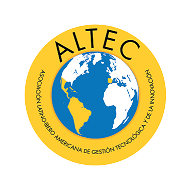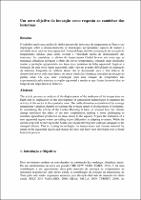| dc.contributor.author | Dias, A. B. | |
| dc.contributor.author | Medeiros, C. B. | |
| dc.date.accessioned | 2021-05-27T15:56:16Z | |
| dc.date.available | 2021-05-27T15:56:16Z | |
| dc.date.issued | 2013 | |
| dc.identifier.uri | https://hdl.handle.net/20.500.13048/1027 | |
| dc.description.abstract | O trabalho expõe uma análise do deslocamento das isotermas da temperatura na Terra e sua implicação sobre o desenvolvimento de tecnologias agropecuárias capazes de manter a atividade deste setor na zona equatorial. A metodologia envolve a estimação da variação de temperaturas médias, para assim estimar a velocidade média de deslocamento das isotermas. Ao considerar os efeitos do Aquecimento Global leva-se em conta que as mudanças climáticas reforçam o efeito das novas temperaturas, tornando mais desafiador manter a produção agropecuária nas áreas mais próximas da linha equatorial. Argúi-se a formação de uma nova região equatorial, onde vigoram grandes dificuldades de adaptação da natureza. Enquanto os cultivos atuais vão se deslocando para o Sul, trata-se de desenvolver novos cultivares dentro de outras condições climáticas alteradas em relação ao padrão atual. Ou seja, criar tecnologias para uma situação de temperatura não experimentada pela natureza na região equatorial e mudar as que foram desenvolvidas ao longo de um largo processo histórico. | |
| dc.description.abstract | The article presents an analysis of the displacement of the isotherms of the temperature on
Earth and its implication on the development of agricultural technologies to maintain the
activity of this sector in the equatorial zone. The method involves estimation of the average
temperature variation, thereby to estimate the average speed of displacement of isotherms.
In considering the effects of the Global Warming it takes in account how the climate
change reinforces the effect of the new temperatures, making it more challenging to
maintain agricultural production in areas closer to the equator. Argues the formation of a
new equatorial region where prevailing major difficulties in adapting to nature. While the
current crop will be moving to the South, one should develop new cultivars adequate to the
changed climate. This is creating technologies for temperatures and climate untested by
nature in the equatorial region and change the ones that have been developed over a broad
historical process. | |
| dc.language.iso | por | |
| dc.rights | info:eu-repo/semantics/openAccess | |
| dc.rights | Atribución-NoComercial-SinDerivadas 2.5 Perú | |
| dc.rights.uri | http://creativecommons.org/licenses/by-nc-nd/2.5/pe/ | |
| dc.subject | Paseo de las isotermas | |
| dc.subject | Objetivo de innovación | |
| dc.title | Um novo objetivo da inovação como resposta ao caminhar das isotermas | |
| dc.type | info:eu-repo/semantics/conferenceObject | |
| dc.relation.conferencedate | 27-31 de octubre, 2013 | |
| dc.relation.conferencename | XV Congreso Latino-Iberoamericano de Gestión Tecnológica | |
| dc.relation.conferenceplace | Porto, Portugal | |
| dc.contributor.corporatename | Fundação Joaquim Nabuco | |


